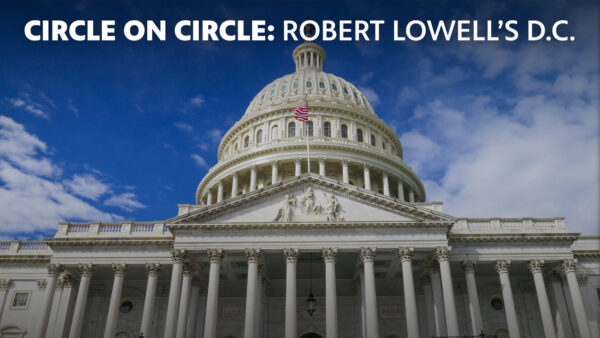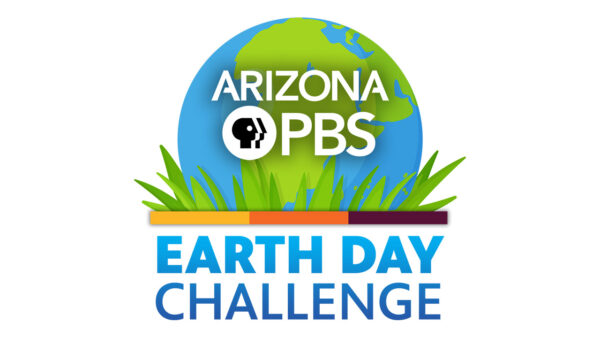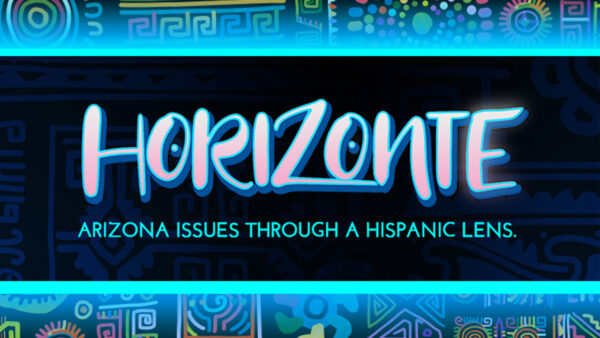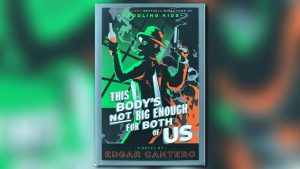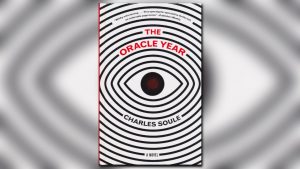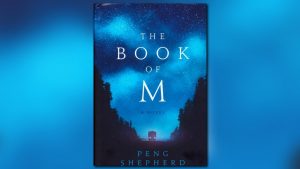Follow the true occurrences of the Voyager Space Craft which was launched into the Solar System in 2012 and then again later in 2015.
This design was created in 1977 and Jim Bell will take readers through the beginnings, endings, findings, and exploration of the Voyager in The Interstellar Age.
He analyses what drives the fantastic team behind the voyager and gives an inside look to one of the most advanced space crafts.
VOICEOVER: And now an Eight original production. Books & Co. is made possible by the Department of English at Arizona State University and by the Friends of Eight, members of Eight Arizona PBS, who give additional gifts to support original programs. Thank you.
ALBERTO RIOS: Welcome to Books & Co. I'm your host Alberto Rios. I'm joined by Jim Bell with his newest book, "The Interstellar Age Inside the Forty Year Voyager Mission." This book takes off like a rocket. How do you incorporate enthusiasm into the text?
JIM BELL: I love space exploration, astronomy, space science, Apollo missions to the moon, Voyager.
It's just a naturally exciting thing for me since I was a kid. I was excited by watching astronauts and space ships and rockets. It kind of flows out.
ALBERTO RIOS: I can't wait to jump into this. We should give a little synopsis about the book. What is this book about?
JIM BELL: It's primarily about the mission called Voyager, which launched in the late 1970s, two spacecraft sent to study the outer solar system for the first time, Jupiter, Saturn, Uranus, Neptune. It's about how these worlds and their moons went from just dots of light in the 1970s to real places with geology and atmospheres, oceans and volcanoes. It's a story about exploration and how we learn to explore the solar system around us.
ALBERTO RIOS: And these Voyagers 1 and 2 have done a pretty good job.
JIM BELL: They have, they are still going, still going strong more than 40 years after launch. They are now traveling out beyond the realm of the planets and passing beyond the realm of the sun's influence on our solar system. They have become interstellar travelers, and along with them, so are we.
ALBERTO RIOS: And they are us.
JIM BELL: They are us, exactly, they are tools. They are machines, they are our eyes and fingers and ears because we can't go out there yet. We can send these silicon-based friends of ours to take pictures and make other measurements and tell us what these other places are like.
ALBERTO RIOS: That does take that idea of removing geography to the extreme, kind of Skypeing out there.
JIM BELL: Yeah, yeah. And we're in contact with them for five or six hours every day. NASA's deep space network around the world.
ALBERTO RIOS: Even still.
JIM BELL: And even at the ranges that they are at, it takes 14, 16 hours at the speed of light for radio signals to get back to the earth. They are way, way out there.
ALBERTO RIOS: It helps us understand something about the insurmountable conceptualization of distance.
JIM BELL: Yes.
ALBERTO RIOS: And speed.
JIM BELL: And space has a lot of space. It's -- it took more than 30 years for these spacecraft to find the edge of the sun's influence on our solar system. And they are the fastest things we've ever built. They have traveling at 10 miles per second. You think about this thing going through your neighborhood, right? 10 miles per second. Yet it still took 40 years to get out where they are now.
ALBERTO RIOS: It's a quirky, interesting little question. 10 miles per second I think maybe would be invisible to the human eye.
JIM BELL: It would be pretty fast, you'd probably see it off at a distance and then it would be
gone.
ALBERTO RIOS: We're probably getting buzzed by who knows what.
JIM BELL: Who knows.
ALBERTO RIOS: You have one line, I think of it as a singular statement. It encapsulated a lot of what you were saying. The line is “Everything exerts a force on everything else. We are all moved by the planets. We are moved by the planets.” That's an ancient idea that's found a 21st century incarnation.
JIM BELL: It's true, from a mathematics point of view, absolutely true. Just the act of sending one of these spacecraft past Jupiter, and using the gravity of Jupiter to slingshot it on to other space, that's took a tiny bit of energy out of Jupiter. Just a trillionth of a whatever. And -- but it's all, it all has to balance out. So there's the physics side of it. But then there's also the emotional side of it, that we are discovering these places. So many people I write about, thousands of people involved in building these spacecraft and launching them and operating them. I played a very minor role as a student but it profoundly affected my career since then. But so many people had their lives -- have their lives dictated by what these spacecraft were doing. It took a long time to travel between Jupiter and Saturn and Uranus and Neptune. People who planned their children in these gaps of time. Or to take a family vacation. It's astrology, right? People's lives dictated by the position of the planets. It's a modern version, a modern twist.
ALBERTO RIOS: If we wave, we must affect the planets.
JB : In a miniscule way, I'm sure.
ALBERTO RIOS: You mentioned earlier, this is perfect timing. You have this wonderful time, the last time this alignment was there was 18th Century. And we were -- our systems then were wooden sailing ships.
JIM BELL: They were the frontiers of exploration. No, it's just the great fortuitous event that a group of physicists and astronomers sort of discovered in the 1960s that the outerplanets would line up just right in the 1970s, so that you could launch spacecraft to go from one to the next to the next to the next without having to send four different missions.
ALBERTO RIOS: Sounds like science fiction.
JIM BELL: It does, and it only happens every 175 years. It won't happen again until the 22nd century. And it was -- they discovered that the alignment would happen, they realized it would happen with enough time to convince Congress that a mission should be launched, this is all funded by your tax money and my tax money and congressional authority. And then to build and launch the spacecraft. They had about a decade, oh, my gosh, by 10 years we have to launch or we'll miss that opportunity. Great timing.
ALBERTO RIOS: It's kind of thrilling.
JIM BELL: It is, very thrilling.
ALBERTO RIOS: And it seems to oddly have worked. You say a very interesting thing, I was surprised by it but I guess I should have known it. The physics of this was really something Isaac Newton had solved.
JIM BELL: It's really not much more complicated than that.
ALBERTO RIOS: That's funny.
JIM BELL: Your joke is it's not really rocket science, it is rocket science, of course, but it really doesn't have to be more complex than 17th and 18th Century physics. There are people who are just very good at it. I'm not one of them, but people who direction these spacecraft. Point them in the right direction, fire the engines at the right time. Celestial mechanics is the field and they are experts at it. They can land rovers on Mars with pinpoint accuracy; it's just really phenomenal how well we understand gravity.
ALBERTO RIOS: Somebody's going to program those computers.
JIM BELL: Back in the day when these missions were being planned, in the mid 1970s, there were no super computers. There were rudimentary computers by today's standards. They did a lot of hand calculations to figure out how to point these spacecraft in the right way. They had 10,000 possible trajectories. They had to do about a lot of hand calculations at the jet propulsion lab in Pasadena. They would use computers on just a few of them in the end, they were using punch cards and old school stuff. But they took that 10,000 possibilities and they found that two -- the two that were the absolutely best and launched Voyager 1 on one, and Voyager 2 on the other.
ALBERTO RIOS: Science fiction writer Robert Heinlein gets so frustrated with the machine, he just pulled out his slide rule.
JIM BELL: That's what they were doing. It sounds reminiscent of something like that.
ALBERTO RIOS: All of this in the midst of telling a story, you also get a chance -- and I as the reader get a chance to have some education regarding vocabulary. You talk about celestial mechanics. I love figuring out what that means. Every page virtually offers something like that. Interstellar wind, magneto tales, helio atmosphere, just sublime, which I think I should have known, and it was wonderful in reading these pages to simply be reminded how to construct these ideas that become these words. You do a very good job of taking us through that. And you lived through it. I think that's why you can.
JIM BELL: Yeah. And I was living through it as a student. So I was learning all these things. I didn't know anything about space physics, you know, the details of cosmic rays and all that kind of stuff. I was learning and watching these people and just reading the news stories coming out and the magazine articles and soaking it up. I don't know if you remember a TV show called "Cosmos" in the 1980s, it had a huge influence on me. Here was guy, Carl Sagan, one of my heroes, a rank and file scientist. He certainly knew what he was talking about with his colleagues, but he could speak English. He could speak on PBS and talk to regular people. I loved the show, my mom loved the show. And so I really learned a lot about communicating complex subjects from people like Sagan.
ALBERTO RIOS: In his plain-speak, there was something else attached to it. You refer to it somewhere in the book, the intangibles almost of the human heart. Why do we do all this? It's not just effectiveness or efficiency, it's something else that we can't quite name except that it's us being human.
JIM BELL: Why did we put a record on those space capsules?
ALBERTO RIOS: Each of the Voyagers has its version of a message. We have the message on the first one, I can't remember what it was called. What did they put in there?
JIM BELL: On the pioneers, they had a plaque. They were two spacecraft just before Voyager, just a plaque. Then the voyagers had these golden records.
ALBERTO RIOS: Both of them had golden records. I can't imagine, you talk about this in some detail. What people had to go through to get that together and how to even conceptualize.
JIM BELL: It is hard to imagine. How would you do it? How would you pick the greatest hits of earth in 1976, 1977, when they were doing this? You have to pick music and pictures, and you could only get about a hundred pictures, only a few dozen songs. You want to put greetings on and what do you have people say. The things I hadn't really realized until doing the research for this book, the team led by Sagan, including artists and other astronomers and musicians and scholars, they only had three weeks do it. They had three weeks to do it. They had to pull all this together. I think they did a fine job. You can go on the internet or find copies of the actual record and listen to the music. It's from all around the world.
ALBERTO RIOS: I did exactly that. I want to take just a moment to remind our viewers that you're watching Books & Co. I'm your host Alberto Rios. You're joined today by Jim Bell, talking about his latest book, "The Interstellar Age." That list of songs, I was listening to it and thinking on some level, what? I've never even heard of that. I was educating myself about my own earth, as much as thinking about it going out somewhere else.
JIM BELL: Right, right.
ALBERTO RIOS: That was an opportunity for us to look at ourselves.
JIM BELL: True. They really wanted to make it about the entire world, not just western music, not just classical music, not just rock-n-roll. Although they sampled all that. The pictures, it's people, it's animals, plants, architecture from around the world. Just a snapshot of what our planet was like in the mid-1970s. They chose to stay very positive. There's no mushroom cloud nuclear explosions, no depictions of famine or war, which is a part of our world. They chose to stay very positive and keep the message sort of very high level, very, you know, enthusiastic and forward-looking.
ALBERTO RIOS: Some scientists thought we should not do that. Steven Hawking among them apparently, at least at first.
JIM BELL: If you're trying to send a message and you don't know who is, what is out there, maybe they are hostile or hungry. But it's kind of a moot point. We've been sending radio and TV out into space for decades, way before the Voyagers were launched. "I Love Lucy," Orson Welles, it's all out there.
ALBERTO RIOS: Let's talk about that. The big planets, the Voyagers got to them and delivered. They gave us news and information that I would say was scientifically shocking.
JIM BELL: Sure, rewrote the textbooks, absolutely.
ALBERTO RIOS: My favorite as a kid drawing the planets, we used to draw the rings around Saturn. It looks like everybody's got a ring.
JIM BELL: Saturn's are the most spectacular. Just seeing those pictures of the rings of Saturn from the other side of Saturn, we never get behind Saturn. We're always closer to the sun on our planet. We see Saturn looking back at it. But to travel behind Saturn and put ourselves in that perspective, a totally new way to look at this world.
ALBERTO RIOS: And to go by these worlds, as quickly as voyagers were moving, they have been their long enough to let these worlds be vibrant and do what they do.
JIM BELL: Even at those speeds it would take days to pass through those systems. Discovering active volcanoes on Io. There's a little moon out there complete erupting itself all the time. Right next to that is Europa. Earth does not have the deepest oceans in the system, Europa does. It's heated from below by tidal forces. What's down there? Anything swimming in that ocean? We have no idea. All of a sudden it's a really exciting place. Saturn's moon Titan, it has thick atmosphere, but it's all nitrogen and methane. Waterfalls and rivers made out of propane. That's crazy, I want to take a picture of that, right? Maybe the early earth was like that. There's this laboratory out there. There's a little moon around Uranus called Miranda. It's got a 10-mile sheer cliff of ice. Jump off that and very gently because of low gravity fall for an hour or so along this icy cliff to the bottom, very gently. Talk about adventure tourism of the future.
ALBERTO RIOS: This is the stuff of science fiction. This is what science fiction imagined.
JIM BELL: It's actually even crazier than science fiction imagined.
ALBERTO RIOS: It's also confusing our vocabularies. You call Io a planet in the book.
JIM BELL: I do.
ALBERTO RIOS: JIM BELL: has been a planet, not a planet, maybe going to be a planet again, who knows. It's an interesting thing that we had thought planets were those things that circled the sun. Now at least in terms of how you're explaining it, we might consider those things that are orbiting planets.
JIM BELL: I look at the object. I try not to judge things or people on where they are but on what they are. And so any object in the solar system that's big enough to have made itself round by its own gravity, maybe it has a core and mantle and a crust, maybe it has an atmosphere, moons of its own, an interesting dynamic geological history. There's Titan around Saturn, Ganymede around Jupiter, huge moons bigger than the planet Mercury, arguably more interesting. But they are the same category of object. They just happen to be orbiting another body. JIM BELL: has an atmosphere, a differentiated world with five moons. Why isn't that a planet? I don't know. I'm a little weird that way. I think the solar system has 30 or 40 planets that we know of and probably a lot more way out there.
ALBERTO RIOS: Certainly puts us in need of more categories.
JIM BELL: Absolutely, absolutely.
ALBERTO RIOS: I want to make sure we have a little time to talk about the helio pause, termination shock, interstellar space and the pioneer anomaly. Can you talk about that a little bit?
JIM BELL: Sure. All stars like our sun create these bubbles around themselves. The sun has all these high energy particles coming off it all the time. It creates light, radiation, pressure. All stars create these bubbles around themselves. We can see when we look out at the Orion Nebula or other star systems, they vary, all different sizes, depending on how old it is and how much energy it gives up. Some people thought the bubble of the sun ends at Saturn.
ALBERTO RIOS: We can think of that as its atmosphere of influence.
JIM BELL: Atmosphere of influence. So from the standpoint of the solar wind, these particles, from gravity's standpoint the sun's gravity influence goes way, way out, almost to the nearest star. From the sun's energy standpoint there is this bubble. Scientists who study these things, space physicists, or space weather people, they have been wondering for decades where does that influence of sun end? Where do you go from all of this weather being created by the star to now you're in a different area. You're in interstellar space between the stars, between the sun's double and the next bubble from the next star over. So after Voyager 2 passed Neptune, last port of call, there were no more planets to look at, no more moons, its mission became find the edge of the bubble. Voyager 1 has popped out of the bubble in 2012.
ALBERTO RIOS: For sure?
JIM BELL: For sure. There was some controversy about it. Voyager 2 is predicted to do that any time. I had asked Ed if he could make it happen for when the book came out, but it hasn't happened as of yesterday. They are heading in slightly different directions sampling different parts of the bubble. For the first time we have a spacecraft out there that we're in contact every day measuring what the environment is like between the stars. Not in our solar system but between the stars.
ALBERTO RIOS: That's the possibility of a new physics.
JIM BELL: It's hard to know, you don't know how many particles are out there. Is the edge of the bubble, the helio pause, is it a sharp edge? Is it ragged? They may be responding to forces they have never seen before. That's where the pioneer anomaly came in.
ALBERTO RIOS: And I think that's something people still wonder about.
JIM BELL: That was from the precursor missions of the Voyagers. Spacecraft was decelerating ever so slightly. People thought maybe there was some bizarre physics force out there. Probably not, probably just the way sunlight bounces off the spacecraft and causes a little deceleration. People are still poring over the data tables to figure that out, as well.
ALBERTO RIOS: We don't really know, but we're closer to it.
JIM BELL: We don't expect anything totally crazy. Physics is the same here and in the center of the Milky Way galaxy, the same solar system, it doesn't matter. It sounds a little arrogant, but we think we have the basic building blocks figured out.
ALBERTO RIOS: So you're saying in 2015.
JIM BELL: We expect some surprises. But those will occur within the realm of our understanding, atomic and molecular physics and gravity and interactions of macroscopic and microscopic bodies. I hope.
ALBERTO RIOS: You never know what the other side of that would be. Maybe you will hope for that.
JIM BELL: You never know.
ALBERTO RIOS: I want to make sure I also mention something we have in common. Those little rockets that you have, I was a kid and we used to build those rockets. It was a big day when we launched that. From our budget, being kids, they were expensive, but what a day.
JIM BELL: Yeah.
ALBERTO RIOS: And I was glad to see you mentioned them.
JIM BELL: I did it, too. I kept trying to figure out how to get a camera onto it. You stuff it into the nose cone and it would be too heavy and the rocket would crash down. I had some explosions, catastrophic incidents on my launch pad. You need more than I can put into these rockets.
ALBERTO RIOS: Which we all thought about and kind of tried.
JIM BELL: It's a great way for kids to learn about science and math and technology, such an important part of our world today.
ALBERTO RIOS: In reading this book, it just reminded me how much I loved those things and that sense of wonder. We're in such an information age we think we kind of know something.
JIM BELL: Yeah.
ALBERTO RIOS: But this book helped me to understand, is there still a lot to wonder about, and a lot we don't know and lot we kind of know.
JIM BELL: And especially with these planets out there. These missions just kind of zipped past. It was just like imagine driving past the Grand Canyon. And you can't get out, you've got keep going, you're heading to California or whatever and you just go past. You see these wondrous sites and you're thinking, we have to go back. A mission with Galileo orbited Jupiter for almost a decade. Passing through looking see rings, all of that in great detail. Those missions are coming.
ALBERTO RIOS: There's one on its way to Pluto.
JIM BELL: It'll pass by July 15th, this summer sort of the last place everybody knows about in the solar system and experts, nobody knows. There are all kinds are predictions. Moons, geysers, who knows? We'll find out this summer, so stay tuned.
ALBERTO RIOS: That is a great way to end this conversation. Jim, I want to thank you for joining us today and I want to thank our viewers for having stuck with this. I think this is a great book and it helps us understand something we went through as kids and are still going through. You've been watching Books & Co. I'm your host Alberto Rios. We've been joined today by scientist and author Jim Bell talking about his latest book, "The Interstellar Age." Please join us again next time when we'll be bringing you another good book. Thank you, Jim.
VOICEOVER: Books & Co. is made possible by the Department of English at Arizona State University and by the Friends of Eight, members of the Arizona PBS who give additional gifts to support original programs. Thank you.
